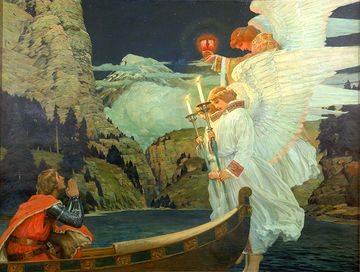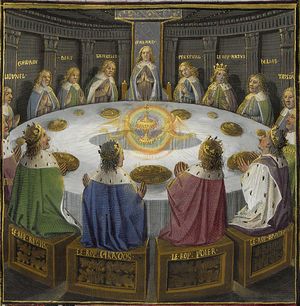Holy Grail

According to Arthurian legend, the Holy Grail, the cup from which Jesus drank at the Last Supper, was brought by Joseph of Arimathea to Glastonbury, which was then an island in southwest England. The focal point was thus set for the dispensation of Camelot, a mystery school founded on the concept of the quest for the Holy Grail as a path of discipline and initiation.
Origins of the Grail legends
According to the legacy of Arthurian tales, Joseph of Arimathea travelled from Jerusalem to Glastonbury soon after the crucifixion, carrying the Holy Grail. Joseph is something of a mystery man in the New Testament. After the crucifixion of Jesus he suddenly appears on the scene, boldly asks Pilate for Jesus’ body, winds it in linen cloth, lays it in what may be his own tomb, and disappears. There are stories about him, not found in the Gospels, that only add to the mystery. Legend has it that Joseph took the cup from which Jesus drank at the Last Supper and brought it to Glastonbury, which was then an island in southwest England.
There is little explanation for the fact that the earliest surviving versions of these stories date from the twelfth century. To some, this sudden appearance sounds like a simple invention by medieval bards, just another romanticization attached to King Arthur. While this may be true, there is a body of evidence—archaeological fact, ancient legend, and tradition—which is hard to dismiss as pure make-believe. Even if this material be only partially true, the questions it raises, the assertions it makes, are hard to ignore.
From the twelfth-century grail romances to Jack Kennedy’s brief shining moment, profiling to Americans the ideals of a nobler age, Arthur and his knights have been more than a fairy tale. Each century has contributed to the Arthurian cycle—through poetry, prose, on stage or screen—a tale with a distinctive cast, making our Camelot into somewhat of a medley, like an English countryseat with architecture dating from Tudor to Victorian as each generation adds a new wing.
The most popular modern stories of King Arthur’s Camelot—from Lerner and Loewe’s Broadway musical to Warner Bros.’ movie to Disney’s The Sword in the Stone (not to mention Monty Python’s spoof)—do not approach the Holy Grail. Their tales are the culmination of centuries of elaboration. But some are convinced that these elaborations have their roots in fact.
Whether fact or fantasy, the Holy Grail has been a persistent thread in our psyche, an archetypal image finally ensconced as a modern-day metaphor. It is worth our while to trace the concept of the fabled cup back to its earliest origins.
Arthurian legend
Arthur himself was a real figure, dubbed the “Great King of the Britons.” According to Arthurian expert Geoffrey Ashe, he was a warrior king who lived in Britain and fought in Gaul, in what is now France, in the late fifth century. Ashe’s research reveals an Arthur “considerably more cultured” than recent historians have pictured him.
The tales of Camelot are as diverse as a royal banquet. The authors of King Arthur stories, like guests eating the most of their favorite dish, tended to indulge in their favorite subject. Some told of courtly love, chivalrous deeds, or chargers and tournaments. Others of nymphs, magicians, and evil spirits in dim forests and dark castles.
Whatever else there may be, there is always the questing knight championing the cause of justice, slaying dragons in the woods of course, seeking romance or adventure, but more often something higher—the Holy Grail. He is immortalized in our collective memory—the pure knight who had “the strength of ten.” Searching, ever-striving, overcoming obstacles in pursuit of his goal.
The mystic vessel of great sanctity played an important role in the stories of the Table Round. It flickered in and out of myriad tales—now clothed in white samite, now veiled in shining mist. It appeared only to those who had most closely attained the ideal of the fellowship—Galahad, Bors, Lancelot, and Percival. It provided the spiritual raison d’être of Arthur’s kingdom.

The appearance of the Grail
According to legend, each year at the feast of Pentecost the knights of the Round Table returned to Camelot and rendered to the king and queen the reports of their deeds during the year. One Pentecost as the knights were gathered at the Round Table they saw a vision of the Holy Grail “so filled with glorious light that none might behold it.” Sir Gawain and many of the others made the vow never to return again to the court until they had seen the Holy Grail more openly.
Alfred Lord Tennyson in Idylls of the King records that upon hearing their vow King Arthur cried, “Woe is me, my knights!... Go, since your vows are sacred, being made. Yet—for ye know the cries of all my realm pass thro’ this hall—how often, O my knights, your places being vacant at my side, this chance of noble deeds will come and go unchallenged, while ye follow wandering fires lost in the quagmire! Many of you, yea most, return no more.”
Of the 150 knights of the Round Table who went forth to quest the Grail, only four saw it—Galahad, Percival, Bors, and Lancelot.
All others were searching for that which they did not understand, which they did not know, for which they did not have the spiritual capacity to perceive. Their grail was the Matter cup; their grail was the responsibility for service to life here and now in the practical domain.
A universal archetype
It is not clear from the mass of conflicting legends what exactly the Grail was or is. It was variously described as a chalice or cup, a stone, a serving dish, or even Christ himself. Most probable is that the mystical Grail presence takes on different forms in the minds of those who see it, or desire to, according to their capacity for understanding.
Other cultures also have heroes who quest grail-like objects. China, India, Tibet, Egypt, Wales, and Ireland are among the nations which preserve legends paralleling the search for the Holy Cup.[1] The coincidences between sets of legends are striking. These outcroppings of the Grail theme are hard to explain merely as versions of the same story transferred by migration. Rather, they seem to take root, flourish and enthrall civilizations around the world because they are an essential element in man’s nature.
Emma Jung, psychologist and wife of Carl Jung, explains in her book The Grail Legend that this phenomenon results from the universal archetypal basis of the theme. She explains that “the fascination and vitality of myths and fairy-tales lie precisely in the fact that they depict basic forms of human experience. For this very reason the same motifs are found the world over, not only as the result of migration but also because the human psyche which produces them is everywhere the same.”[2]
The significance of the Grail today
El Morya speaks of the mystical significance of the Holy Grail today:
Oh, there is a Holy Grail indeed! and long ago it was placed at Glastonbury. But, precious ones, today it has been spiritually amplified until replicas of that Holy Grail are placed as a filigree radiance of light around each human heart who aspires to become a chalice of Christed opportunity. And so tonight I tell you that the Holy Grail is within your own heart, and you are knights to guard that Grail against impure thoughts, impure motives, impure desires, impure ideas of every type and kind.[3]
The concept of the physical cup, the tangible Grail that the mind and hand can grasp, is the magnet that rallies souls to take up the spiritual quest—lifetime after lifetime—of discovering and becoming the inner light and the Holy Grail.
See also
Sources
Elizabeth Clare Prophet, Inner Perspectives, chapter 23.
Heart magazine, winter 1985 issue.
Elizabeth Clare Prophet, July 4, 1978.
